A Cool Fountain Pen Review: Platinum Cool
Yes I know I am picking some low hanging fruit but get used to it because I am going to run it into the ground. This was my third pen I acquired, though I actually got 3 pens on the same day so that fact is up for debate. Platinum is a Japanese company founded in 1919, under the name Nakaya but soon changed to Platinum Pen Company in 1924. Thus, Platinum was founded the latest of the big 3 fountain pen companies in Japan: Sailor, Pilot (Namiki) and Platinum (Nakaya). I put Nakaya with Platinum, but actually Nakaya is another company founded in 1999 by the grandson of the founder of Platinum, who ended up becoming the president of Platinum too. Basically, Nakaya employs retired craftsmen from Platinum and they end up making handcrafted pens, and thus the Nakaya company creates the high-end works of art compared to the mass-produced Platinum pens. However, the pen parts from both companies are compatible (probably I don’t own a Nakaya pen) with each other. They share the same nib size, feed and converter as a result.
A bit off topic, but back to the Platinum Cool, if you live outside of Japan. The Cool and the Platinum Balance are actually the same pen, except for the colour options for the pens. The Balance has gold coloured trim and comes in opaque black, green, blue and wine red, whereas the Cool has chrome trim and transparent clear, pink and blue colours. In Japan, there is no Cool model, just the Balance with a different name. Even the model number is just shows it as a sub-model: PGB-3000 and PGB-3000A. Thus, if you import this pen from Japan, you will need to look for the name Platinum Balance Shine (or Shining) Crystal.

I bought this pen via Rakuten from Penhouse for about $23, and the converter for about $5. When purchasing pens from Japan, they often do not come with converters, perhaps due to the culture of buying additional parts (that fit between models such as New Nintendo 3DS not coming with the charger due to sharing the same charger as the old 3DS).
Now, purchasing this pen in North America, you’re looking at $42 USD. Depending on shipping, with a converter, you pay about the same or a little less out of Japan. If you drive down the shipping from Japan with more items that are cheaper from Japan (Pilot, Sailor inks, or another pen), then you will get a better deal out of Japan.
Unboxing


The Platinum Cool comes in a fairly simple cardboard sleeve with the name “Platinum” on the box. Sliding the case out, you are presented with a clear case. The pen came with a warranty card, showing the date of purchase, how to use and warning information, which I don’t remember how it was placed inside the case so I left it outside. The pen is sitting in the case held with a ribbon to keep it from bouncing around. This kind of packaging is very common in fountain pens, and basically all my reviews after this will show it. The Platinum Cool also came with a cartridge of blue-black ink which I haven’t used though I am curious now that I think about it. The cartridge is stopped by a metal ball agitator so I have an interest of refilling the cartridge with a syringe.
Features
The Platinum Cool is a stainless steel nib pen that comes in Fine and Medium sizes. The pen takes the proprietary Platinum cartridge and converters. The converters are the same across all models that I know of, and are easy to disassemble for cleaning or greasing. The ink capacity of the converter is comparable to most converters, at just over 0.5mL of volume.
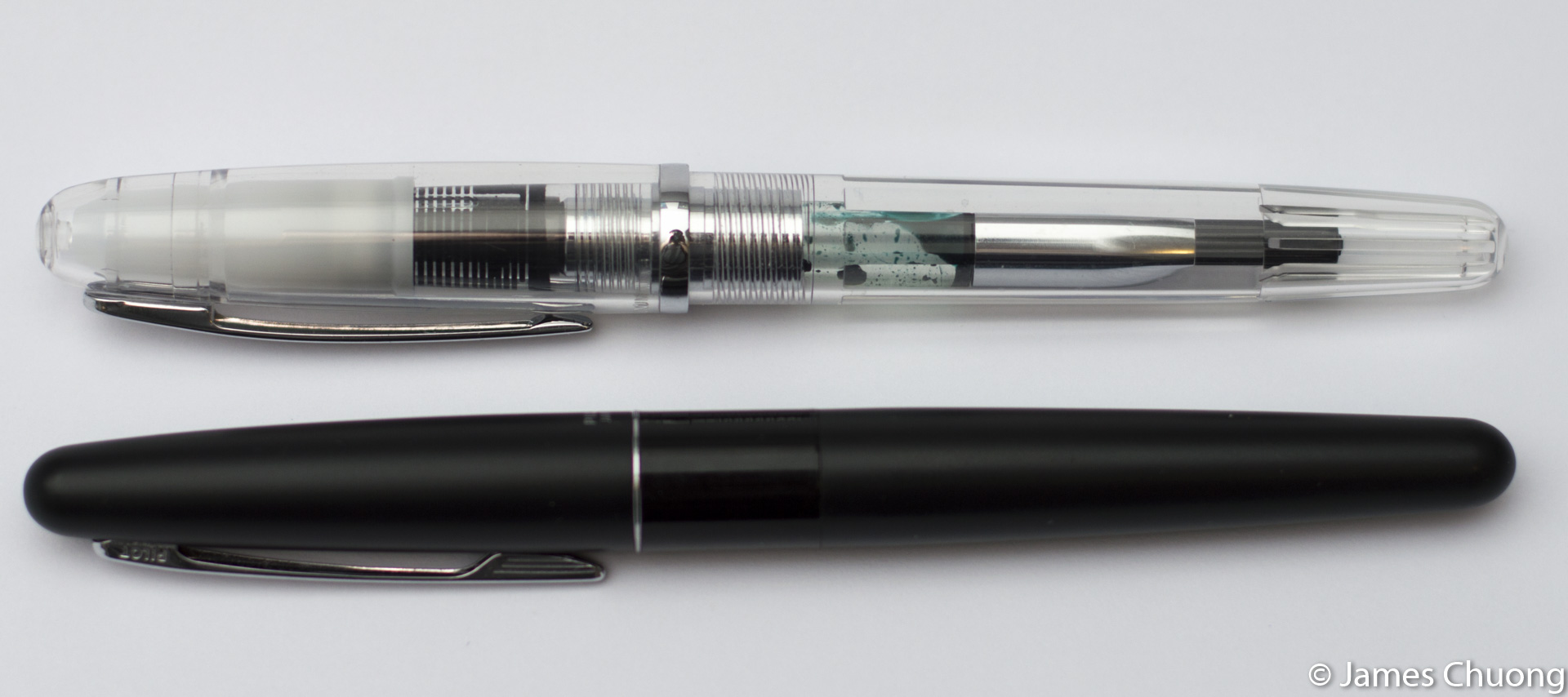
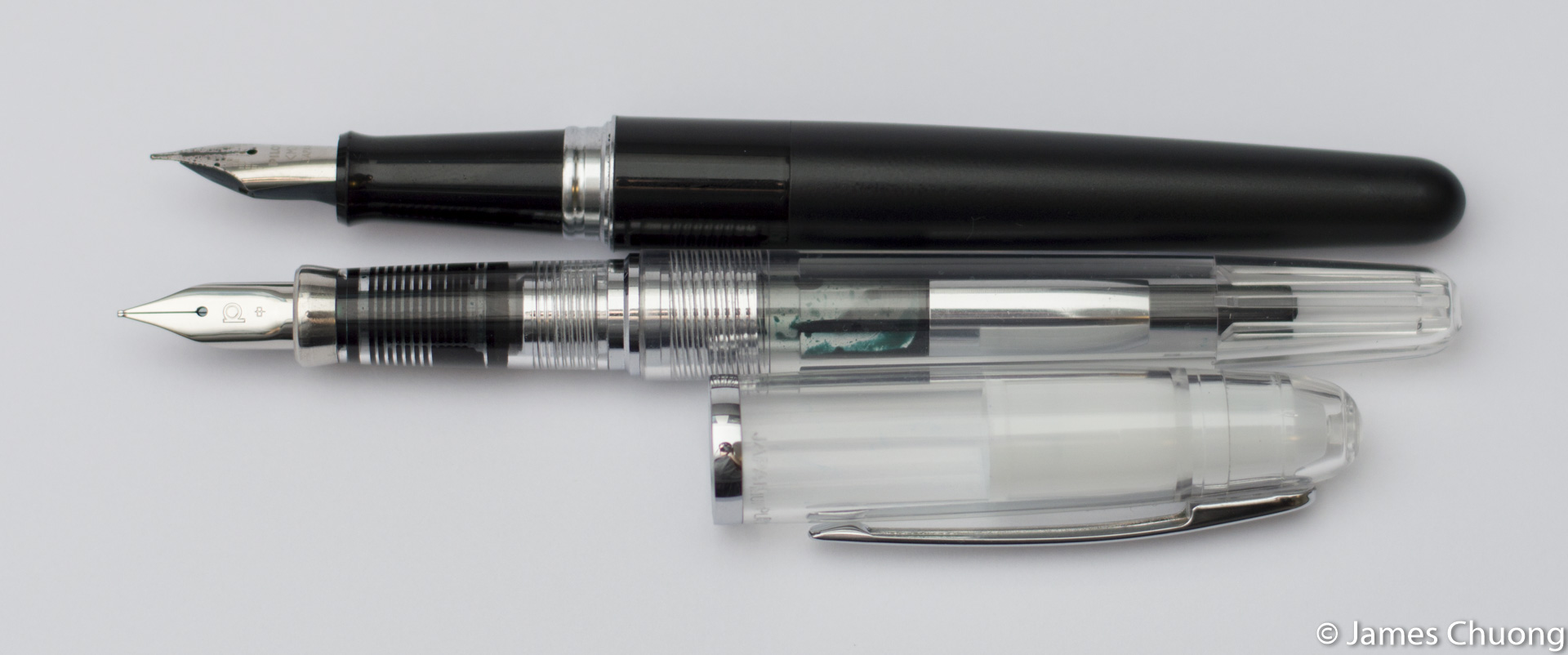
The Platinum Cool is a comparable size to the Pilot Metropolitan, though a little bit longer in the body (uncapped), with a slightly longer section.

The cap is a snap-cap, with a nice and satisfying click to lock it in place. When capped, the cap can freely rotate around the body, which has no real impact but doesn’t give it a very solid feel.
The cap is also push to post, and sits deeply and securely on the back of the pen. Furthermore, the grip is a straight, tapering towards the nib in which there is a metal collar which flares out. This keeps your fingers from slipping all the way to the nib. The step down between the section and the body is nice and shallow, which makes it a little more comfortable to hold in that area.
The real draw of the Platinum Cool is the demonstrator look, with the transparent section and feed. More on this in the next section.
Looks
Beauty is in the eye of the beholder. For the most part the pen looks rather cool. The transparent body is neat, and goes well with the chrome trim. The pen is a simple and classic cigar shape, with the cap being wider than the body of the pen.

The nib is very simple looking, it takes a modern shape as the tines do not flare out as much. It is only stamped with the Platinum logo P and the character 中 which is “middle” or “medium” in Japanese.
Not pictured, the cap has the words “Platinum” in silver, and “Japan” engraved. The clip is also very simple, with a borderline around the front, and a slight curved shape.
However, the one major con to the design of the cap is the white inner cap to prevent drying out. It is a completely opaque white, which is very strange considering the fact the rest of the pen is clear. It looks out of place and not very cool since it hides part of the clear section,feed and nib.

The clear section and feed allows you to see the ink as it travels from the cartridge/converter to the nib. Realistically, the feed fins don’t all get coloured in, especially if you only use cartridges, as the feed fins wouldn’t get saturated in that case. This is also unfortunate because it means not all fins will be equally coloured in, making an imbalanced look. From the picture you can see that the fins near the nib are nicely coloured, whereas the ones near the converter are being overly saturated in ink. You can also see the ink path down the slit towards the tip of the nib.
Writing Experience
The Platinum Cool is a Japanese pen, so the point is slightly finer than a normal Western medium, but it does not have any unpleasant feedback. In fact, it is quite smooth, with an interesting feedback feel to it. I did end up doing a little smoothing to the nib because I had initially suspected a minor case of baby’s bottom but I am not even certain of that. Writing with the pen is fairly pleasant, with a little feedback and it makes a sound that reminds me of writing with a pencil. The pen is also a little on the moderate-wet side. Not a gusher, but enough to show off some shading.
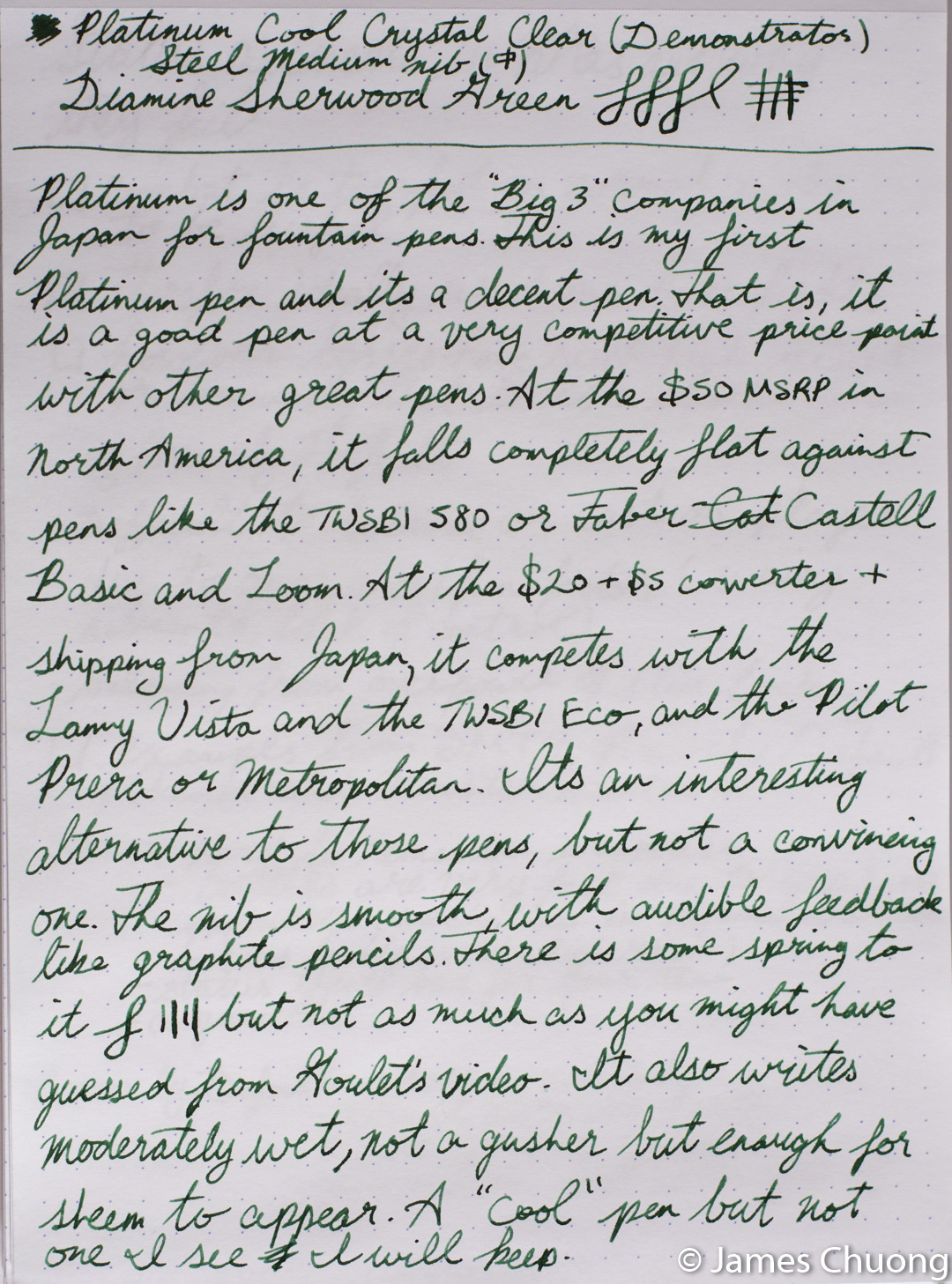
The ink I used in this review is Diamine Sherwood Green on a Rhodia No. 16 Dotpad.
One of the things that drew me to purchasing this pen was the “springiness” of the nib. Brian Goulet made a video series about the Platinum Cool (this links to the writing sample video of the playlist) and I was interested in how much “flex” you could get out of this pen. Unfortunately, I wasn’t able to get nearly that much line variation, nothing what was shown in his video. I was able to get some, but this was hard to incorporate into writing normally, and did not flex as much. Maybe there is a break-in time through metal fatigue but I wasn’t really willing to push it that far.
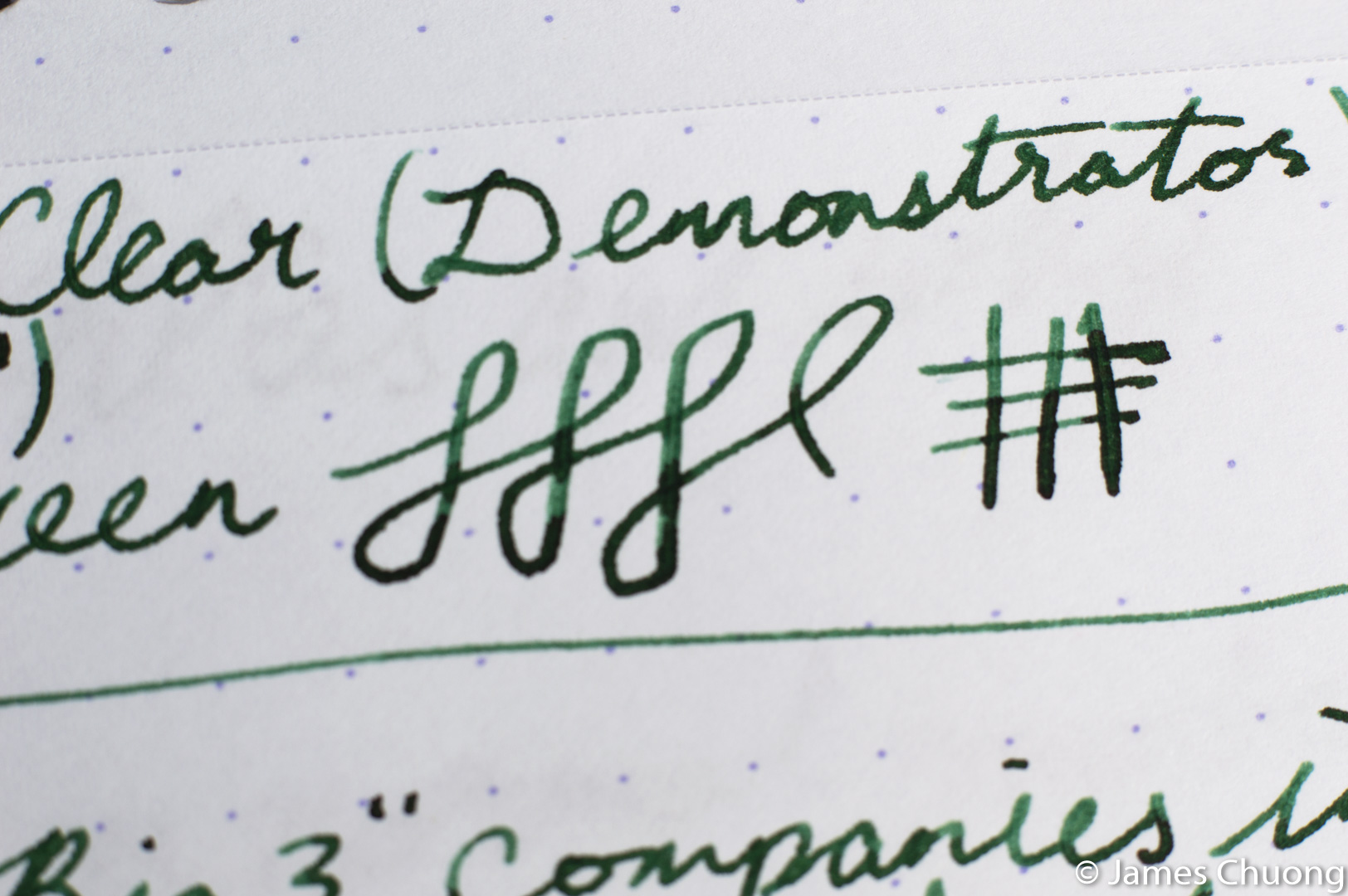
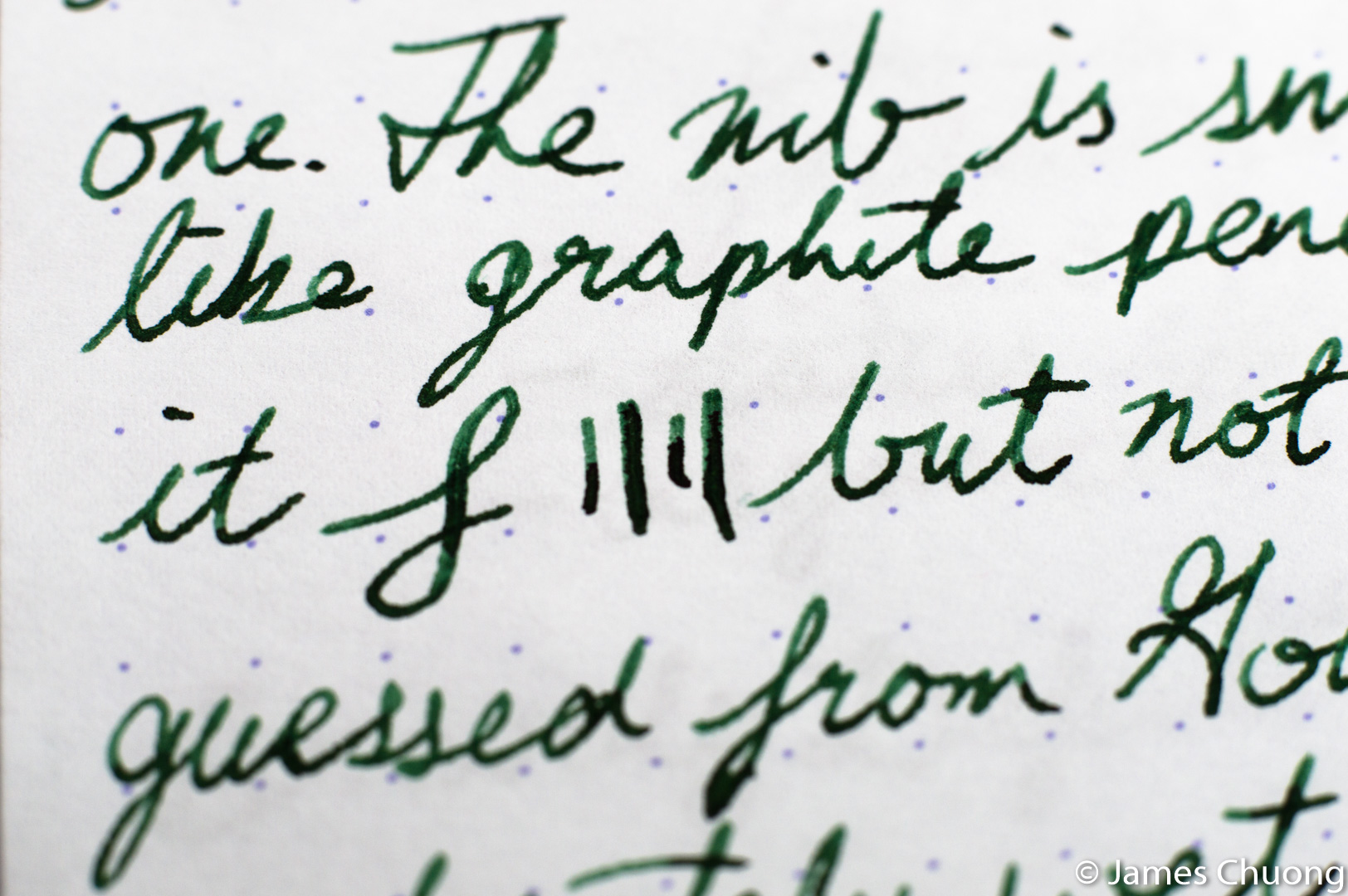
However, it is still a little springier than some other steel nibs I have tried.
Misc and Final Thoughts
I think the Platinum Cool is a fairly standard, entry-level pen. It looks decent, feels decent, writes decent, is lightweight and somewhat springy. But at the same time, if we look at the competition we find that the Cool is somewhat lacking in competitive features.
At $30 from Japan, we have the Lamy Safari (Vista), and the TWSBI Eco as the direct competitor to the Platinum Cool. Other considerations would be the Pilot Metropolitan ($15, half the price of the Cool), Noodler’s pens: Nib Creaper, Ahab, Konrad (“flex” pens, for tinkering), Kaweco Sport (pocket pens, nibs are wetter, broader). The Safari is a classic, and allows easy swapping with extra Lamy nibs, but otherwise is about equal to the Cool. The Eco blows the Cool out of the water with the piston mechanism, and similar, maybe even nicer looks.
At the $42 dollar price point, you have the aforementioned pens, the Konrad in acryllic/ebonite, the Faber-Castell Basic and Loom, and the TWSBI 580, Mini and Classic.
The Konrad is also a piston filler with many interesting colour options, an ebonite feed and takes #6 nibs which makes it a fun pen to tinker with, or use as a flex pen.
The Faber-Castell Basic and Loom models are both well known for their amazingly smooth nibs, and have nice metal bodies.
The TWSBI pens are all piston fillers with the 580 and Mini having the faceted sides which look much better than the Cool. Again, TWSBI dominating the sub-$100 mark.
The direct competitor to the Cool is Pilot’s Prera, which comes in multiple colour accents (clear, with some colour on the ends), and uses the same nib as the Metropolitan. The Prera also comes in an italic nib if you so desire, another one-up on the Cool. Finally, the Prera is able to be converted to an eyedropper filled pen, if you wanted. The Cool has the metal piece which would not allow an eyedropper conversion, not to mention the ends are actually not completely sealed.
So in all honesty, the competition is so fierce at both price ranges, the Platinum Cool’s only interesting feature is the springy nib. It’s a decent pen, but I don’t see why I wouldn’t get any of the other pens over the Cool, as it doesn’t really have a niche for its usage. I don’t see myself keeping this pen, as the money would be better spent on that my collection is lacking.
Finally, I also had a lot of trouble with cleaning the feed out. The pen is easily disassembled but cleaning the feed from any leftover ink or stains, completely out is an adventure not worth pursuing. It would probably be easier with an ultrasonic cleaner (in fact if I owned one I wouldn’t hate it so much), but the feed is made in a way that the bottom side of the feed gets much less flow through it, thus ink isn’t flushed out that bottom half. At least that is my thought, but in practice no matter how I flushed it would not get the ink out. I found that long soaks would eventually just dissolve the ink but it’s slow. If you continually ink the same ink, or don’t really care about very small discolorations, you will not mind. I like it squeaky clean, so I must clean it.
Final Verdict: Not cool enough to stay.
Disclaimer: I purchased this pen with my own money and was not compensated for this review. There are no referral links in this review.